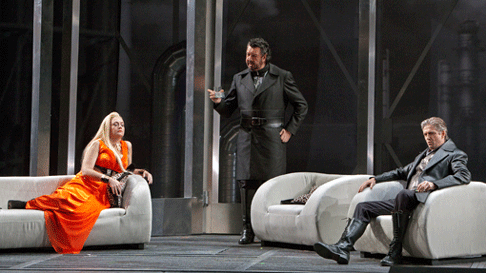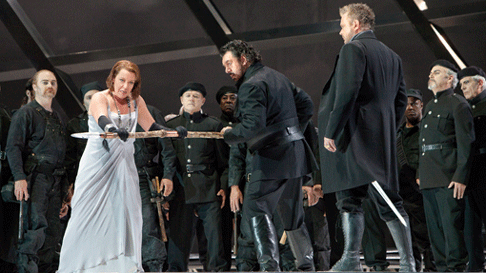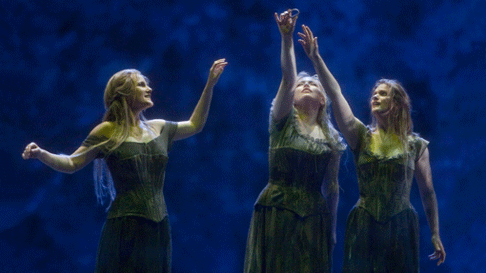![Nina Stemme (Brünnhilde) and Ian Storey (Siegfried). [Photo by Cory Weaver courtesy of San Francisco Opera]](http://www.operatoday.com/Gott-DR-1.gif)
06 Jul 2011
Der Ring des Nibelungen in San Francisco
Some of the experts said it was the best Ring ever, others merely said it was one of the best (these were lecturers at a Wagner Society symposium).
English Touring Opera are delighted to announce a season of lyric monodramas to tour nationally from October to December. The season features music for solo singer and piano by Argento, Britten, Tippett and Shostakovich with a bold and inventive approach to making opera during social distancing.
This tenth of ten Live from London concerts was in fact a recorded live performance from California. It was no less enjoyable for that, and it was also uplifting to learn that this wasn’t in fact the ‘last’ LfL event that we will be able to enjoy, courtesy of VOCES8 and their fellow vocal ensembles (more below …).
Ever since Wigmore Hall announced their superb series of autumn concerts, all streamed live and available free of charge, I’d been looking forward to this song recital by Ian Bostridge and Imogen Cooper.
Although Stile Antico’s programme article for their Live from London recital introduced their selection from the many treasures of the English Renaissance in the context of the theological debates and upheavals of the Tudor and Elizabethan years, their performance was more evocative of private chamber music than of public liturgy.
Evidently, face masks don’t stifle appreciative “Bravo!”s. And, reducing audience numbers doesn’t lower the volume of such acclamations. For, the audience at Wigmore Hall gave soprano Elizabeth Llewellyn and pianist Simon Lepper a greatly deserved warm reception and hearty response following this lunchtime recital of late-Romantic song.
For this week’s Live from London vocal recital we moved from the home of VOCES8, St Anne and St Agnes in the City of London, to Kings Place, where The Sixteen - who have been associate artists at the venue for some time - presented a programme of music and words bound together by the theme of ‘reflection’.
'Such is your divine Disposation that both you excellently understand, and royally entertaine the Exercise of Musicke.’
‘And there was war in heaven: Michael and his angels fought against the dragon; and the dragon fought and his angels, And prevailed not; neither was their place found any more in heaven … that old serpent … Satan, which deceiveth the whole world: he was cast out into the earth, and his angels were cast out with him.’
There was never any doubt that the fifth of the twelve Met Stars Live in Concert broadcasts was going to be a palpably intense and vivid event, as well as a musically stunning and theatrically enervating experience.
‘Love’ was the theme for this Live from London performance by Apollo5. Given the complexity and diversity of that human emotion, and Apollo5’s reputation for versatility and diverse repertoire, ranging from Renaissance choral music to jazz, from contemporary classical works to popular song, it was no surprise that their programme spanned 500 years and several musical styles.
The Academy of St Martin in the Fields have titled their autumn series of eight concerts - which are taking place at 5pm and 7.30pm on two Saturdays each month at their home venue in Trafalgar Square, and being filmed for streaming the following Thursday - ‘re:connect’.
The London Symphony Orchestra opened their Autumn 2020 season with a homage to Oliver Knussen, who died at the age of 66 in July 2018. The programme traced a national musical lineage through the twentieth century, from Britten to Knussen, on to Mark-Anthony Turnage, and entwining the LSO and Rattle too.
With the Live from London digital vocal festival entering the second half of the series, the festival’s host, VOCES8, returned to their home at St Annes and St Agnes in the City of London to present a sequence of ‘Choral Dances’ - vocal music inspired by dance, embracing diverse genres from the Renaissance madrigal to swing jazz.
Just a few unison string wriggles from the opening of Mozart’s overture to Le nozze di Figaro are enough to make any opera-lover perch on the edge of their seat, in excited anticipation of the drama in music to come, so there could be no other curtain-raiser for this Gala Concert at the Royal Opera House, the latest instalment from ‘their House’ to ‘our houses’.
"Before the ending of the day, creator of all things, we pray that, with your accustomed mercy, you may watch over us."
The doors at The Metropolitan Opera will not open to live audiences until 2021 at the earliest, and the likelihood of normal operatic life resuming in cities around the world looks but a distant dream at present. But, while we may not be invited from our homes into the opera house for some time yet, with its free daily screenings of past productions and its pay-per-view Met Stars Live in Concert series, the Met continues to bring opera into our homes.
Music-making at this year’s Grange Festival Opera may have fallen silent in June and July, but the country house and extensive grounds of The Grange provided an ideal setting for a weekend of twelve specially conceived ‘promenade’ performances encompassing music and dance.
There’s a “slide of harmony” and “all the bones leave your body at that moment and you collapse to the floor, it’s so extraordinary.”
“Music for a while, shall all your cares beguile.”
The hum of bees rising from myriad scented blooms; gentle strains of birdsong; the cheerful chatter of picnickers beside a still lake; decorous thwacks of leather on willow; song and music floating through the warm evening air.
![Nina Stemme (Brünnhilde) and Ian Storey (Siegfried). [Photo by Cory Weaver courtesy of San Francisco Opera]](http://www.operatoday.com/Gott-DR-1.gif)
Some of the experts said it was the best Ring ever, others merely said it was one of the best (these were lecturers at a Wagner Society symposium).
The final curtain down at last on the second cycle, the audience leapt to its feet and roared. What was all the fuss about?
The delights of the San Francisco Ring were myriad. The cycle played out over a mere six days during which Wagner’s drama did not seem to stop. It was an immersion Ring rather than episodic one as the Freyer Ring in L.A. seemed over its ten long days, not to mention the Berlin Philharmonic Ring in Aix-en-Provence that was spread over four years.
Conductor Donald Runnicles slid into the initial E flat pedal tone and relentlessly sustained Wagner’s orchestral deliberation for its seventeen hour duration. The maestro drove an orchestral continuum that was imperceptibly fleet (it was actually fast), its speed though was calibrated to the careful articulation of Wagner’s score, the conductor knowing that Wotan’s plight and designs give rise to riveting music only when they are musically exploited to the maximum.
Mo. Runnicles achieved a rare transparency of orchestral sound in the War Memorial, the percolating inner voices of the continuum often shining brilliantly in the vast space of the hall as they can never do in the recordings we use to learn and casually listen to the Ring. And too the vast spaces of the War Memorial allowed huge fortes to roll forth, immersing the hall in mighty sound, Even the quirks of the hall contributed, its “golden horseshoe” overhang magnifying the eight horns and double timpani for those of us seated on the right side of the orchestra.
The careful musical exposition was subject to the largest arc of Wagner’s myth, the orchestral climax of the entire Ring occurring about sixteen hours into it, only at the end of the second act of Götterdämmerung when Mo. Runnicles unleashed it all for Brünnhilde’s pact with Hagen to murder Siegfried. This Ring was bigger than its pieces, and we understood that the usual frenzy we missed at the conception of Siegfried was measured against the hugely complex dilemma of his death.
It is futile to discuss the concept of the production, San Francisco Opera touting it as “an American Ring.” There were indeed vibrant American images, like redwood trees. like American industrial wastelands, but the Gibichung headquarters was well beyond the 1930’s American skyscrapers director Francesca Zambello cites in her program book apology, and much more on the scale of Austrian expressionist Fritz Lang’s immense Metropolis of his 1927 film. And too the light green behind Brünnhilde’s fire seemed more like a weird color choice that an evocation of escaping industrial gases.
 Melissa Citro (Gutrune), Andrea Silvestrelli (Hagen) and Gerd Grochowski (Gunter)
Melissa Citro (Gutrune), Andrea Silvestrelli (Hagen) and Gerd Grochowski (Gunter)
All these specific images however quietly dissolved into the careful storytelling that was the hallmark of the Zambello production. Not a musical motive was left without a corresponding movement on the stage, no musical interludes were left on an abstract imaginative level but accompanied by moving projections — clouds, water, trains, fire, more clouds, etc. It was a fully illustrated Ring (take it or leave it) that (if you took it, and that took a while) eased you, even gracefully, inside the Ring’s musical universe.
It was an easy, engaging Ring that deflated Wagnerian philosophical pomposity at every turn with surprising, sometimes funny twists — Alberich attached to his homeless supermarket cart searched for Faftner with infrared binoculars, the forlorn Rhine maidens hopelessly picked up plastic bottles from a dried up river bed, beer guzzling buddies who were actually sworn enemies downed cases. Not to mention the purely comic book, utterly delightful visuals for Fafner and Fasolt, or the Valkyries parachuting onto the rocks of Valhalla (this image said to have been borrowed from a Swedish commercial for a detergent powder).
Finally the Zambello Ring maybe even arrived at tongue-in-cheek with the black covered Arab-esque women cowering in the wake of their men, black uniformed fascistic soldiers of Hagen’s evil army. Not to intimate that Mme. Zambello did not somehow make all this bring Wagner alive. She did.
 Nina Stemme (Brünnhilde), Andrea Silvestrelli (Hagen), Ian Storey (Siegfried) and Ensemble
Nina Stemme (Brünnhilde), Andrea Silvestrelli (Hagen), Ian Storey (Siegfried) and Ensemble
San Francisco Opera promoted a number of seminars to accompany its Ring, Anti-Semitism was a big topic, though it was put in succinct perspective by the Mime of the production, David Cangelosi who rhetorically asked “haven’t we turned the page on all that?” Distinguished lecturers examined the Ring in Schopenhauerian terms, a former Buddhist monk delineated the Ring’s roots in Buddhism. The most convincing of the philosophical analogies described the Ring in purely Sartrean Existential terms. (I might also mention a concert of Wagner transcriptions on the 5000-pipe organ of St. Mary’s Cathedral — the Ride of the Valkyries executed by four hands and four feet and those 5000 pipes).
Well, none of that for the San Francisco Ring. While there were two real dogs portraying wolves, a bear played by a real man and a number of fantastic and dead animals involved, there was no horse at all for Brunnhilde to ride into the flames. The flames were fed by the downtrodden Gibichung women and the Rhine maidens throwing the plastic bottles picked up from the riverbed (tossed there by males in the context of this production). Gutrune, a male-victimized “moll” embraced Brünnhilde and we understood that she was redeemed. Photographs of the fallen heros rescued by the Valkyries showered down and at last a young girl planted a tree. Mo. Runnicles had had his fun with the murder pact, the usually spectacular ending instead was musically rather resigned.
This was not a minimal Ring created by veteran opera designer Michael Yeargan. There were four superimposed prosceniums and a sentient floor (lighted from underneath) that served as the stage mechanism for the Wagner mega-drama, with full stage screens flying in and out at all depths of the stage to capture the inexhaustible catalogue of projections developed by Jan Hartley and her associates. If the freeway interchange under which Wotan saw Siegmund die and where he murdered Hunding was not life size it seemed so. Hunding’s mountain cabin was as good as real as was Mime’s wrecked Airstream trailer.
What, you may ask, held all this together. It was the Brünnhilde of Swedish soprano Nina Stimme who brought bonafide Teutonic style to rock solid vocal production and muscular physicality to her indefatigably energetic Valkyrie. This Ring was Brünnhilde’s personal story, placed in even higher relief by the pallid portrayal of Wotan by American bass Mark Delavan, a performance that effaced the Wagnerian complexities and emotional stature of this human father cum transcendent being. The suspicion lurks that this was the intention of Zambello, a suspicion founded on the portrayal of Siegfried as one step above the village idiot, charmingly rendered by Jay Hunter Morris in Siegfried, and less vividly but vocally far more convincing by English tenor Ian Storey in Götterdämmerung.
 Lauren McNeese, Renée Tatum and Stacey Tappan (The Rhinemaidens).
Lauren McNeese, Renée Tatum and Stacey Tappan (The Rhinemaidens).
There were several performances that stood out among the universally good performances of the entire cast. The Siegmund of American tenor Brandon Jovanovich was disarmingly charismatic and Italian basso Andrea Silvestrelli created Zambello’s arch villain Hagen with supreme testosterone gusto. American tenor David Cangelosi as Zambello’s creepy hobo Mime succeeded in making the first two acts of Siegfried high points (well, among many) of the entire cycle.
San Francisco Opera does not seem to have been a competitor in who-can-spend-the-most-for-a-Ring contest. Still, there went a pile of gold. One assumes costumer Catherine Zuber was well rewarded for what was an heroic and immensely successful effort, as was the complex lighting of Mark McCullough — both seasoned opera pros, like Zambello and Yeargan and their supporting teams.
It was not a prestigious Ring, like the Aix Ring with the Berlin Philharmonic in the pit (by the way with the six harps Wagner requires — San Francisco made do with two) with its elegant, minimalist staging by Stéphane Braunschweig. It was not an arty Ring imagined in a rarefied visual language like the splendid L.A. Achim Freyer Ring, nor was it a big, international house Ring with proven big name interpreters and the flavor-of-the-day producer (by the way that would be the Robert Lepage Ring at the Met).
The San Francisco Ring was a good Ring, if a wacky one that seemed at times like it might even be a spoof. It was however, perhaps therefore absolutely understandable. The experts may debate how it betrayed or illuminated Wagner’s musico-philosophic treatise, but they too will admit that those seventeen hours in the War Memorial Opera House were full of fun and richly rewarding.
Michael Milenski